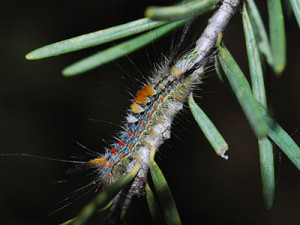
BOULDER, Colo. – Douglas-fir trees located in pocket areas along the Front Range, including Boulder, Douglas and Jefferson counties, are currently experiencing defoliation from the Douglas-fir tussock moth. Damage caused by this pest can be severe, and a high degree of mortality in severely affected trees can be expected by impacted landowners.
The full extent of the outbreak will be mapped this summer as tree damage becomes more visible, and through aerial surveys conducted by the Colorado State Forest Service and USDA Forest Service during the last week of July.
“Under outbreak populations, the larvae will eat the needles of trees and can eventually defoliate whole trees and impacted forest stands,” said Ben Pfohl, assistant district forester with the CSFS Boulder District.
He says that besides damage the moth larvae cause to trees, they also can negatively affect humans. Hairs found on the caterpillars and cocoons can cause severe allergic reactions in some people who come into direct contact with them, so those who live, work and recreate in affected areas should take caution.
The Douglas-fir tussock moth is a native pest of Colorado’s forests. In Colorado, the primary host trees are Douglas-firs, but the insect also can attack white firs and spruce trees while in its larval, or caterpillar, stage. Typical outbreak cycles occur every 7-10 years in Colorado, and outbreaks can last up to three years.
Pfohl says that while management actions to deal with the moth usually are unnecessary, during severe outbreaks numerous insecticidal applications are available for controlling the pest. Individual landowners can protect individual, high-value trees through the application of approved insecticides, but broad-scale aerial application of insecticides – although effective – are not recommended due to collateral damage on non-target insects. Concerned landowners should consult with a local, licensed tree-care company to determine which trees to treat and the best treatment options.
Tussock moths start their life cycle as caterpillars, eating new needles on the upper and outer edges of trees in April and May and producing a red or brown cast on affected trees. The larvae continue to feed on older needles through summer, causing the trees to become defoliated, before spinning cocoons to pupate into adult moths starting in late July. There are many natural predators of this insect, most notably a virus known as “wilt disease,” which typically reduce populations within a few years.
CSFS foresters are working with local fire departments, Boulder County and affected HOAs to determine the extent of the outbreak and to provide information to those affected. Questions about the moth and current infestation can be directed to Ben Pfohl, CSFS Boulder District, at (303) 823-5774.

